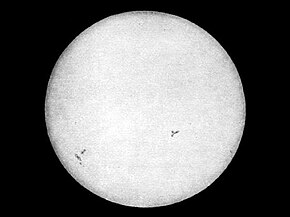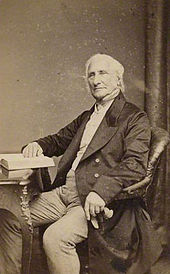Solar cycle 9
| Solar cycle 9 | |
|---|---|
 The Sun in 1845, during solar cycle 9 | |
| Sunspot data | |
| Start date | July 1843 |
| End date | December 1855 |
| Duration (years) | 12.4 |
| Max count | 219.9 |
| Max count month | February 1848 |
| Min count | 17.6 |
| Spotless days | 655 |
| Cycle chronology | |
| Previous cycle | Solar cycle 8 (1833–1843) |
| Next cycle | Solar cycle 10 (1855–1867) |

Solar cycle 9 was the ninth solar cycle since 1755, when extensive recording of solar sunspot activity began.[1][2] The solar cycle lasted 12.4 years, beginning in July 1843 and ending in December 1855. The maximum smoothed sunspot number observed during the solar cycle was 219.9 (February 1848), and the starting minimum was 17.6.[3] During the solar cycle minimum transit from solar cycle 9 to solar cycle 10, there were a total of 655 days with no sunspots.[4][5][6]
Solar cycle 9 began in 1843, the year that Heinrich Schwabe discovered the sunspot cycle.[7] During this cycle, Edward Sabine, Rudolf Wolf, and other scientists recognized that solar disturbances affected the Earth's magnetic environment, so that solar cycles are identical to the Earth's geomagnetic cycles. Wolf also introduced the Wolf number during this period.
The phenomenon now known as geomagnetically induced current was seen for the first time during this cycle – it became apparent on the emerging electric telegraph network. Francis Ronalds, Honorary Director of the Kew Observatory and Sabine's colleague, received data from telegraph operators on the movements of their magnetic needles for comparison with his own photo-recordings of atmospheric electricity and geomagnetic intensity variations but had insufficient resources to study the causes of the unexpected currents in detail.[8][9]
Geomagnetic activity during solar cycle 9 followed a double-peaked distribution, with more magnetic storms during the rising (1847–48) and falling (1851–54) parts of the cycle.[10]
See also
References
- ^ Kane, R.P. (2002). "Some Implications Using the Group Sunspot Number Reconstruction". Solar Physics. 205 (2): 383–401. Bibcode:2002SoPh..205..383K. doi:10.1023/A:1014296529097. S2CID 118144552.
- ^ "The Sun: Did You Say the Sun Has Spots?". Space Today Online. Retrieved 12 August 2010.
- ^ SIDC Monthly Smoothed Sunspot Number. "[1]"
- ^ Spotless Days. "[2]"
- ^ Dr. Tony Phillips (11 July 2008). "What's Wrong with the Sun? (Nothing)". NASA. Archived from the original on 14 July 2008.
- ^ Solaemon's Spotless Days Page. "[3]"
- ^ Claudio Vita-Finzi. Solar History: An Introduction, p. 4, Springer, 2012 ISBN 9400742959.
- ^ Ronalds, B.F. (2016). Sir Francis Ronalds: Father of the Electric Telegraph. London: Imperial College Press. ISBN 978-1-78326-917-4.
- ^ Ronalds, B.F. (2016). "Sir Francis Ronalds and the Electric Telegraph". The International Journal for the History of Engineering & Technology. 86: 42–55. doi:10.1080/17581206.2015.1119481. S2CID 113256632.
- ^ Nevanlinna, H.; Ketola, A.; Häkkinen, L.; Viljanen, A.; Ivory, K. (23 April 1993). "Geomagnetic activity during solar cycle 9 (1844–1856)". Geophysical Research Letters. 20 (8): 743–746. Bibcode:1993GeoRL..20..743N. doi:10.1029/93GL00836.
- v
- t
- e
| 1740–1759 |
|
|---|---|
| 1760–1779 |
|
| 1780–1799 |
|

| 1800–1819 |
|
|---|---|
| 1820–1839 |
|
| 1840–1859 |
|
| 1860–1879 |
|
| 1880–1899 |
|
| 1900–1919 |
|
|---|---|
| 1920–1939 |
|
| 1940–1959 |
|
| 1960–1979 |
|
| 1980–1999 |
|
| 2000–2019 |
|
|---|
 | This article related to the Sun is a stub. You can help Wikipedia by expanding it. |
- v
- t
- e















